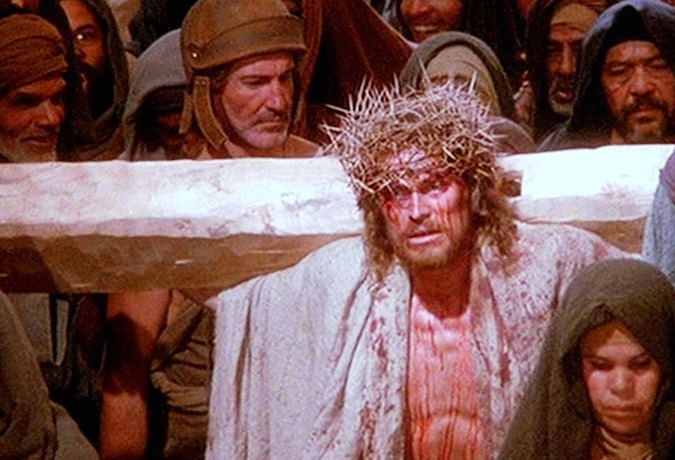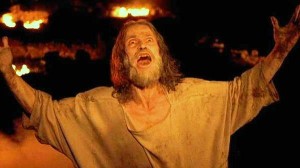
“The dual substance of Christ – the yearning, so human, so superhuman, of man to attain God… has always been a deep inscrutable mystery to me. My principle anguish and source for all my joys and sorrows from my youth onward has been the incessant, merciless battle between the spirit and the flesh… and my soul is the arena where these two armies have clashed and met.”
– Nikos Kazantzakis, author of the book “The Last Temptation of Christ”
This quote arrives in the pre-titles to The Last Temptation of Christ (1988), adapted by Martin Scorsese (“GoodFellas, Raging Bull”) who struggled through most of the 1980’s in order to get it made. It is well-known that Scorsese himself is a lifelong dedicated Italian Catholic who had considered priesthood before he went into filmmaking. When Scorsese found the Kazantzakis novel it was a not a traditional Jesus biopic but instead a unique exploration of the divinity of Jesus. Controversy on the film existed before shooting began. In fact, in 1983 the $20 million dollar production green-lit by Paramount Pictures went into turnaround after right-wing fundamentalist Christian groups conducted an unceasing series of petitions and protests to have it stopped.
Scorsese plundered himself unto other projects, them being “After Hours” (1985) and “The Color of Money” (1986) – terrific, if relatively safe, genre pictures – until he was able to find alternative investors for the film. Universal Pictures agreed to be the financial backers of the film in late 1987 but only contributed to an $8 budget to the film. In 1983, Jesus was to be played by Aidan Quinn and filmed in Israel but was now replaced by Willem Dafoe and filmed in Morocco with a minimalist sparseness on harsh locations.
“The Last Temptation of Christ” respects the Gospels, anybody with intelligence can see that. The final third steers in a controversial new direction, for that’s what offended. If Jesus was more than a deity but a man, then he had to have both wisdom and self-doubt, both strength and fragility. Here’s the touchy part: Scorsese portrays Jesus as a coward and conflicted man before he chooses the right path. This is more compelling to us as not just viewers, but as human beings, to consider Jesus this way instead of as some kind of invincible divinity.
In depiction of his early cowardice, Jesus assists in the crucifixion of a fellow Jew who is guilty of sedition. Rome is a place occupied by hatred and persecution, and its fellowship is comprised of conformists that act upon the word of Pontius Pilate (David Bowie). Jesus is consumed by following society’s orders because he fears the penalty of heresy administered by Rome. He has a calling to go to the desert to await his Father’s message where after forty days he is beckoned to be the Messiah of the people. He does so, but remains conflicted. He wishes he was not the chosen one.
Harvey Keitel as Judas, is the most confrontational of the Apostles and yet the most loyal and confiding to Jesus. Barbara Hershey as Mary Magdalene is a tattoo-adorned prostitute marked by change when she pays witness to the miracles of Jesus, yet there remains skepticism between them – is her son a fraud? The fact that these characterizations are not representations of Sunday school postcards upset conservative groups that want to see Jesus as a perfect sage of wisdom as well as being impervious to pain.
The harrowing crucifixion scene of Jesus is not induced by the hands of Satan but by the hands of Rome. Satan has made several appearances, but the most important time is when he disguises himself in goodness. It’s Satan that tempts to free Jesus from his martyrdom. So here, Kazantzakis and Scorsese (again, controversially) explore a what-if: If Jesus had not died on the cross and become our Savior, it’s likely he would have married and settled with his family. In the film, his temptation is to be an ordinary man.
 Of course, Scorsese’s point of the film, the revelation he wants you to see, is if Jesus had not died for his followers that we are able to articulate the depth of importance of what his death meant. But it is recalled that his big monologue scene with Jerusalem burning in the background at the end, the usually ecstatic Scorsese went up to him after the first couple of takes and grumbled, “Is there anything more you can give?” On a subsequent take, Dafoe realizing he was disappointing his director, delivered a magnificent take that found depths of great sorrow and remorse, one that has to be considered one of the great actor moments. Dafoe in the scene and film entire astonishing as the self-tortured Jesus.
Of course, Scorsese’s point of the film, the revelation he wants you to see, is if Jesus had not died for his followers that we are able to articulate the depth of importance of what his death meant. But it is recalled that his big monologue scene with Jerusalem burning in the background at the end, the usually ecstatic Scorsese went up to him after the first couple of takes and grumbled, “Is there anything more you can give?” On a subsequent take, Dafoe realizing he was disappointing his director, delivered a magnificent take that found depths of great sorrow and remorse, one that has to be considered one of the great actor moments. Dafoe in the scene and film entire astonishing as the self-tortured Jesus.
Just as powerful as the lead performance is Peter Gabriel’s music, particularly the “It is accomplished” theme. Mournful music as it should be, but somehow it connects emotions of two thousand years ago with how we feel about Jesus dying for our sins today. After genuine filmmaking burrowed in bleakness, Gabriel’s main theme serves as catharsis.
Right-wing fundamentals groups opposed the film after its release in August of 1988. At a Parisian movie theater, there were Molotov cocktails thrown inside the theater which injured thirteen people, four of them permanently left with major burn scars for life. Evangelist Bill Bright offered to buy the prints from Universal so that he could destroy them all permanently. How very Christian of these people!
Scorsese has made more thrilling films to my eyes, but “The Last Temptation of Christ” will always be one of the most important of all films to my soul. It made me wake up and realize that the times of Jesus wasn’t made up of treacly miracles the way my Sunday school books were lamely teaching us. Scorsese makes us comprehend Jesus’ sacrifice was far more significant because choices back then were far more cruel. It would take more than ten years, but “Last Temptation” would change the standards in Hollywood’s Biblical epics.
164 Minutes. Rated R.
DRAMA / LIBERAL MINDS / WEEKEND FOOD FOR THOUGHT
Film Cousins: “The Gospel According to St. Matthew” (1964, Italy); “Kundun” (1997); “Passion of the Christ” (2004); “Exodus: Gods and Kings” (2014).





